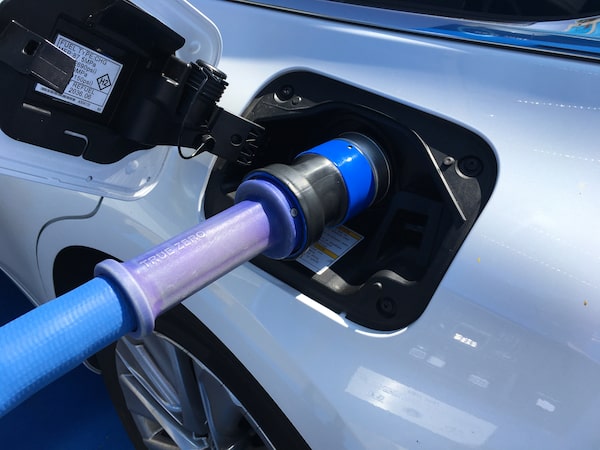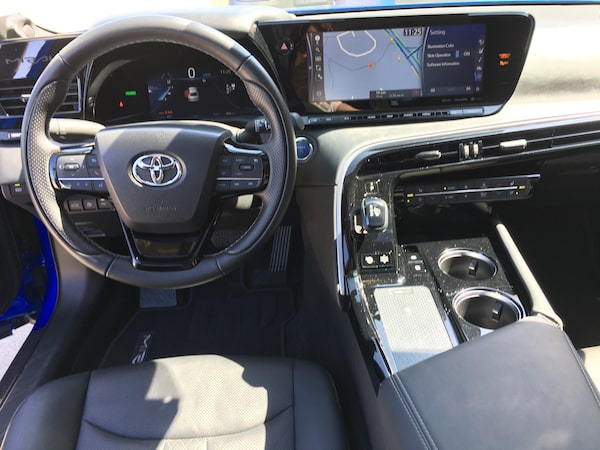
2022 Toyota Mirai.Petrina Gentile/The Globe and Mail
Filling up with hydrogen is similar to gas. Open your fuel door, attach the nozzle and fuelling begins. In about five minutes, the second-generation 2022 Toyota Mirai should have enough fuel to travel about 650 kilometres.
But with four cars in front of us waiting for the sole hydrogen fuel dispenser at a San Diego station, the five-minute fill-up is currently just a dream.
Jackie Birdsall, senior engineering manager at Toyota Motor North America, and I waited about 45 minutes before giving up on trying to refuel. She says the process typically takes more than an hour.
At the pump is a man in his 20s refuelling his first-generation Mirai, which made its debut back in 2015 as the first mass-market hydrogen vehicle in North America. The woman behind him, driving a Hyundai Nexo, paces anxiously outside her vehicle. He appears to be done, but is struggling to remove the nozzle – because it’s frozen. (A common occurrence at some stations, nozzles can freeze during refuelling and they can take several minutes to defrost.) Compressors keep the hydrogen at below-freezing temperatures, but on hot California days, the compressor might need to reboot between fills. In this case, it takes nearly 10 minutes for the nozzle to unlatch and release from his vehicle.
“Really, [the biggest hurdle to adoption] is the hydrogen dispensers themselves,” said Birdsall, who was driving with me. “What we need to do is invest in placing those hydrogen dispensers – and not just one at a fuelling location, we need to have several at fuelling stations – so customers aren’t stuck in these long queues. It doesn’t matter if it only takes you five minutes to refill. If you’re car No. 8 in line, you’re going to be waiting at the station for a while,” she said.
Newer stations like the ones near her home in Los Angeles typically have four dispensers at one location. With more storage capacity, stations can provide fuel for 500 to 1,000 zero-emission hydrogen vehicles a day. But she said more stations are needed in California and Canada. The lack of fuelling locations is likely a big reason Toyota has sold just 247 Mirais in Canada since 2019.

While hydrogen is expensive to produce, it currently costs less to fill up a Mirai than a gas-powered Toyota Camry.Petrina Gentile/The Globe and Mail
Currently, there are 50 active stations in California with an expected 15 more to come within the next 12 to 18 months. In Canada, there is one fuelling station in Quebec. Two more are expected by 2023. In British Columbia, there are four active stations with nine more expected by 2024.
Birdsall said governments need to invest similar amounts of money in hydrogen infrastructure as charging infrastructure for electric vehicles, pointing to a five-year, $280-million program from Natural Resources Canada. Less than $20-million of that is allocated to hydrogen stations. According to Natural Resources Canada, the average cost of a station for light-duty vehicles is $3.7-million, although that is dependent on a number of factors including if the hydrogen has to be delivered, on-site storage capacity, if it is a stand-alone station or a hydrogen pump at a conventional station and the technology used.
“We can’t just rely on BEVs [battery electric vehicles],” she said. The electrical grid is vulnerable to power outages, such as those caused by the wildfires on the west coast in California and Canada, she explained, and if the grid is down, you cannot charge an electric vehicle.
While hydrogen is expensive to produce, it currently costs less to fill up a Mirai than a gas-powered Toyota Camry. ”In Canada, hydrogen costs roughly $13 per kilogram. The Mirai holds 5.6 kilograms, which makes the full refill of a Mirai about $75,” she said. At $2 a litre, with the Camry’s 61-litre capacity it would cost $122 to fill up.
Not only does Toyota have an uphill climb convincing car buyers that hydrogen is an economical and convenient option, but it must also dispel myths around safety.
“Hydrogen is flammable, but so is gasoline. Really, any energy source or energy carrier is flammable,” Birdsall said. “People think of hydrogen as a scary, volatile molecule. But we’ve used hydrogen safely in industrial, commercial processes for over 50 years. So we know how to handle it and how to store it.”
The Mirai has been tested in a bonfire and had bullets shot at it without igniting, she said.
Like its name, the Mirai, which means “future” in Japanese, offers a glimpse of some promising zero-emission technology, yet it doesn’t feel out-of-this-world. In fact, it feels like a conventional, gas-powered Camry.
“It’s meant to be kind of remarkably unremarkable in that it drives like a traditional vehicle and it feels like a traditional vehicle,” Birdsall said. “It’s meant to completely replace a conventional vehicle as far as the customer goes. However, it’s zero emission.”

The Mirai offers a glimpse of some promising zero-emission technology, yet it doesn’t feel out-of-this-world.Petrina Gentile/The Globe and Mail
Tech specs
2022 Toyota Mirai Hydrogen Fuel Cell Vehicle
Price: Base price/as tested: $54,999/$76,750
Powertrain: Fuel cell electric powertrain (AC synchronous electric generator and electric motor) mated to three hydrogen carbon fibre reinforced onboard tanks
Battery: Lithium ion
Battery capacity: 1.24 kilowatt-hours
Horsepower/torque (lb-ft): 182/221
Drive: Rear-wheel drive
Claimed range: 647 kilometres
Alternatives: Hyundai Nexo, Honda Clarity
Looks
Not as polarizing as the first-generation Mirai, it’s tasteful and attractive in its design. It’s lower, longer and wider than the first generation. Cool colours, like Hydro Blue, are distinctive – just like this vehicle.
Interior
Spacious and nice-looking cabin with seating for five. Moving the fuel cell stack from under the front seats to under the hood creates more interior space. The 12.3-inch centre touch screen is intuitive and easy-to-use. But I don’t like the volume buttons – there are no traditional dials. You have to hit one button to increase and another button to lower the volume.

The 12.3-inch centre touch screen is intuitive and easy-to-use.Petrina Gentile/The Globe and Mail
Performance
Refined, quiet, smooth and comfortable. Ride and handling are similar to a gas-powered vehicle like a Toyota Camry. Built on a rear-wheel-drive platform, which is a major departure from the first-generation’s front-wheel-drive platform, it feels composed and well-balanced, even when cornering.
Technology
A fuel-cell electric powertrain powers the Mirai; hydrogen is converted into electricity through an on-board fuel cell. Hydrogen is stored in three carbon fibre reinforced and bulletproof tanks under the hood. The hydrogen capacity has also increased by 30 per cent compared with the first generation.
Cargo
Cargo space is on the small side – about 272 litres – and the rear seats don’t fold down or have a pass-through for hauling longer items.
The verdict
A smart, zero-emission vehicle that’s competent and impressive. Too bad the infrastructure isn’t more widely available to make it a viable alternative to a traditional gas-powered vehicle or BEV.

Hydrogen is stored in three carbon-fibre reinforced and bulletproof tanks under the hood.Petrina Gentile/The Globe and Mail
The writer was a guest of the auto maker. Content was not subject to approval.
Shopping for a new car? Check out the new Globe Drive Build and Price Tool to see the latest discounts, rebates and rates on new cars, trucks and SUVs. Click here to get your price.